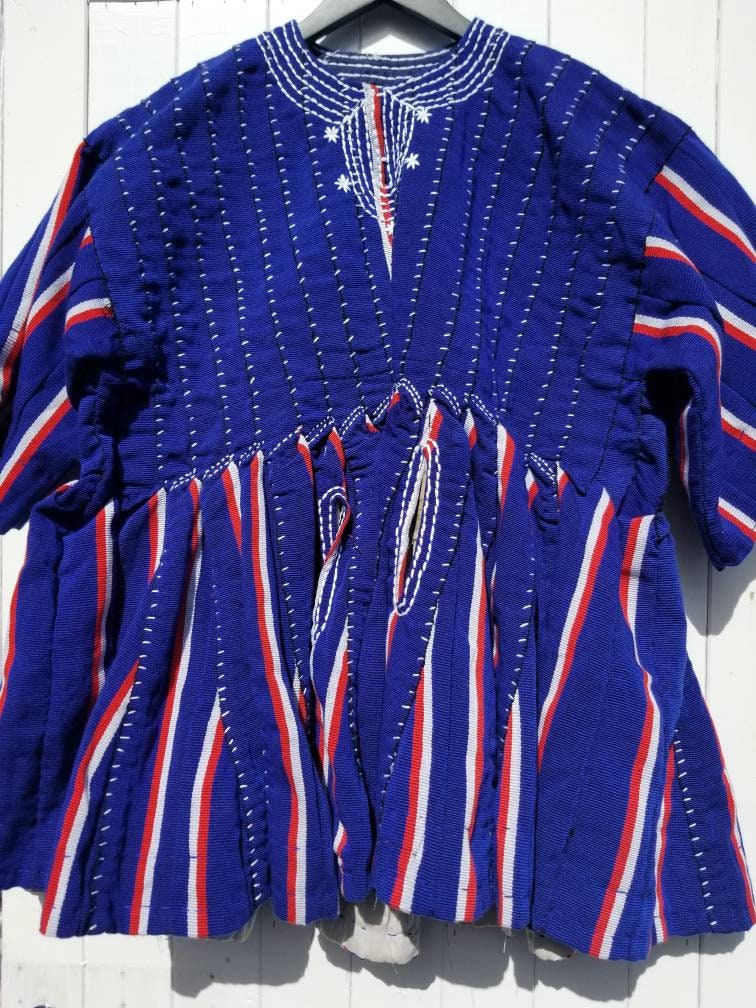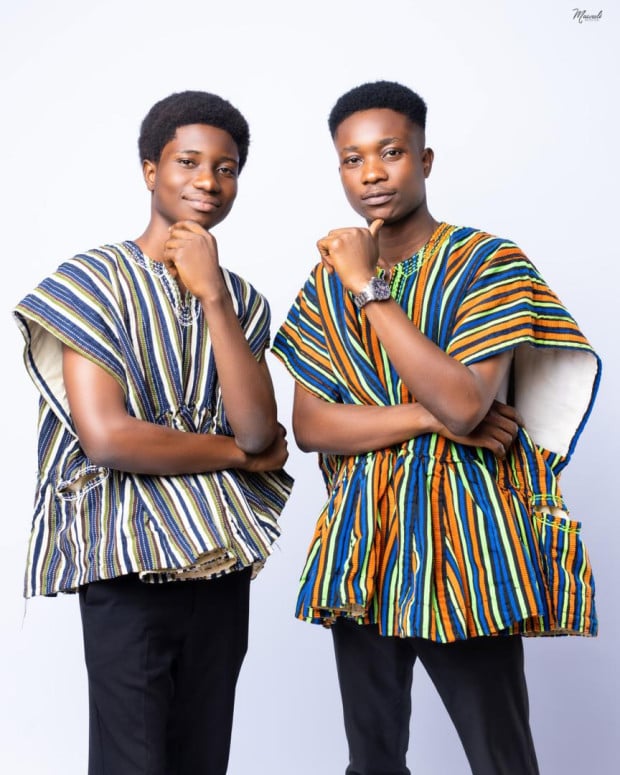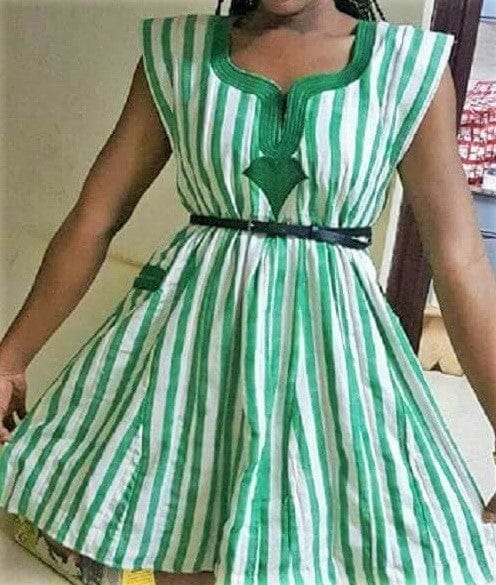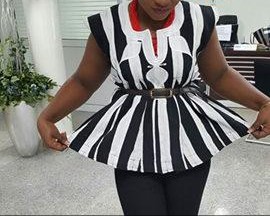The "fugu" dress, also known as "smock" or "batakari," is a traditional garment from northern Ghana and is widely associated with the cultures of the Dagomba, Mamprusi, Mossi, and other ethnic groups in West Africa. It is a symbol of African heritage, particularly for the people of northern Ghana, and reflects cultural identity, history, and craftsmanship.
also known as "smock" or "batakari," is a traditional garment from northern Ghana and is widely associated with the cultures of the Dagomba, Mamprusi, Mossi, and other ethnic groups in West Africa. It is a symbol of African heritage, particularly for the people of northern Ghana, and reflects cultural identity, history, and craftsmanship. This loose-fitting top originated in northern Ghana, but is now worn in many areas of West Africa, and has become popular around the world. It is called fugu, or batakari, among other terms in Ghana, and is generally made from hand-woven strips of fabric with wedge-shaped godets inserted below the chest to give it a flared shape.
This pattern is great for fabric artists, weavers, and fabric lovers. Almost any fabric will do, from your own woven strips to regular yardage - just tear or cut it into strips and sew the strips together. 
A striking top, the Ghanaian Smock is worn by men and women (women's version has elastic at the waist). Men often wear the Smock over trousers or shorts, and it can be worn by women over pants, leggings, or when made longer, as a dress on its own. Long or short sleeved shirts can be worn underneath the Smock.
A kufi cap completes the outfit, and is included in the pattern. Embroidery motifs for Smock are also included.
Suggested fabrics; Cottons and cotton blends, wool, rayon, silk. Weight of facing fabric should be similar to or slightly lighter than garment fabric. Also traditionally, Aso Oke, a handwoven cloth from West Africa that is woven in strips.
How it is made
The smock is traditionally made from hand=loomed strip comprising a blend dried and unddyed cotton yarn. It is intricate sewn together by hand resulting in a distinctive plaid pattern that characterize the smock. Some variation showcase additional artistic elements, such as embroidery adoring the neckline. A significant accessory to the smock is the Zipligu, a hat worn in conjunction with this traditional attire,
1. Origins and Cultural Significance.jpg?alt=media&token=d9943e17-5357-4e1a-b26a-5d0a1a49ffac)
The fugu dress originates from northern Ghana, where it was traditionally worn by men. The word "fugu" is derived from the Dagbani language, meaning "cloth" or "dress." It is also known as "batakari" in the Hausa language.
Historically, the fugu was worn by warriors and hunters, often during battles and special ceremonies. It was believed to have protective spiritual qualities, sometimes enhanced by charms or amulets sewn into the fabric.
Over time, the fugu has become a symbol of cultural pride and identity for people from northern Ghana and has gained popularity across the country. It is now worn during various important events such as festivals, traditional ceremonies, weddings, funerals, and even by political leaders to showcase cultural heritage.
2. Design and Weaving Techniques
The fugu dress is made from handwoven cotton fabric. The cloth is woven into narrow strips using traditional looms, which are then sewn together to create a wide garment. The weaving technique involves intricate patterns and designs that often signify cultural meanings or social status.
The fabric used for fugu is typically thicker and heavier than that used for kente, which helps to create the garment's distinct appearance. It may feature stripes, patterns, or plain colors depending on the region and personal preference.
The dress usually has wide sleeves and is worn loose, often accompanied by a matching hat called "kufi." Some fugu garments are adorned with embroidery or additional embellishments to enhance their appearance.
3. Symbolism and Cultural Expressions
Colors and Patterns: The colors used in fugu often carry specific cultural meanings. For example, black and white stripes may represent purity and simplicity, while blue and indigo are associated with spirituality and wisdom.
Spiritual Protection: Traditionally, the fugu was not only a garment but also a spiritual armor. Warriors would wear it into battle, with talismans and charms sewn into the fabric to provide protection against harm. This belief in the fugu's protective qualities is still present in some cultural practices.
4. Modern Adaptations and Usage
The fugu has evolved into a fashion statement beyond its traditional use. It is now worn by people from all regions of Ghana and even beyond the country’s borders. The garment has been modernized into various styles, such as fitted shirts, dresses for women, and contemporary suits, while still retaining its cultural roots.
Prominent figures, including politicians, musicians, and cultural leaders, often wear fugu during public appearances to showcase Ghanaian heritage and support local artisans.
It is also used as a symbol of Pan-Africanism and cultural pride, with many Ghanaians wearing it during Independence Day celebrations and other national events.
5. Economic Impact and Preservation
The production of fugu supports local economies, especially in northern Ghana, where weaving is a significant source of income for many families. The craft is often passed down through generations, with young weavers learning the skill from their elders.
Efforts to preserve the tradition include cultural festivals, workshops, and exhibitions that celebrate the art of fugu weaving. There are also initiatives to promote the dress on a global scale, emphasizing its cultural significance and the craftsmanship involved.
6. Regional Variations and Influences
While the fugu is most commonly associated with northern Ghana, similar garments can be found among other West African ethnic groups, such as the smocks worn by the Mossi people of Burkina Faso and the Agbada of Nigeria.
Each region has unique weaving styles and design preferences, allowing for a diverse representation of traditional dress while maintaining a shared cultural heritage.
The fugu dress is a powerful expression of African heritage, symbolizing history, cultural identity, and the craftsmanship of the people of northern Ghana. It serves as a connection between the past and present, adapting to modern fashion while preserving its traditional roots.
Men's smocks
Men's smocks, known locally as "Batakari" or "Fugu" in Ghana, are traditional garments typically associated with the northern regions of the country. These smocks are made from handwoven strips of cotton fabric sewn together, featuring distinctive patterns and designs. They often have short or long sleeves and are loose-fitting, which makes them comfortable and suitable for various weather conditions.
The smocks are usually worn during cultural festivals, ceremonies, and special occasions. They can be plain or intricately embroidered with colorful threads to add a decorative touch. The outfit is often paired with matching trousers and a traditional hat, completing the look.
Women's smocks
women's smock is a loose-fitting garment that typically extends over the upper body, often worn as a protective layer or a casual outfit. Traditionally, smocks were used by artists, farmworkers, and craftspersons to protect clothing underneath. Today, women's smocks come in various styles and can be worn as dresses, tops, or tunics..jpg?alt=media&token=a8ed771c-54f1-4530-a7c2-0e89d8f616ab)
The smock is comfortable garment that can serve as either a top, tunic, or dress. It originated as practical workwear for protection but has evolved into a fashionable clothing piece. Modern women's smocks come in various styles and can be used for casual or semi-formal occasions.
Modern smocks for women often feature:
Loose and comfortable fit: Allows for ease of movement.
Pleating or gathered fabric: Adds texture and volume.
Decorative embroidery or patterns: Often used to enhance the aesthetic appeal.
Various lengths: They can be tunic-length or dress-length.
Characteristics of a women's smock include:
Loose fit: Allows for ease and comfort, typically falling straight down without much shaping.
Length options: Can range from hip-length tops to knee or calf-length dresses.
Design elements: May feature pleats, gathers, or smocking (a decorative stitching technique) for added texture.
Fabric choices: Often made from lightweight materials like cotton, linen, or muslin for breathability
Today, smocks can be styled with leggings, jeans, or even worn on their own as dresses, making them versatile for different looks and seasons.
Smocks can be worn as casual wear, beach cover-ups, or even as fashionable pieces paired with leggings or jeans.
 also known as "smock" or "batakari," is a traditional garment from northern Ghana and is widely associated with the cultures of the Dagomba, Mamprusi, Mossi, and other ethnic groups in West Africa. It is a symbol of African heritage, particularly for the people of northern Ghana, and reflects cultural identity, history, and craftsmanship.
also known as "smock" or "batakari," is a traditional garment from northern Ghana and is widely associated with the cultures of the Dagomba, Mamprusi, Mossi, and other ethnic groups in West Africa. It is a symbol of African heritage, particularly for the people of northern Ghana, and reflects cultural identity, history, and craftsmanship.

.jpg?alt=media&token=a8ed771c-54f1-4530-a7c2-0e89d8f616ab)


.jpg?alt=media&token=d9943e17-5357-4e1a-b26a-5d0a1a49ffac)




